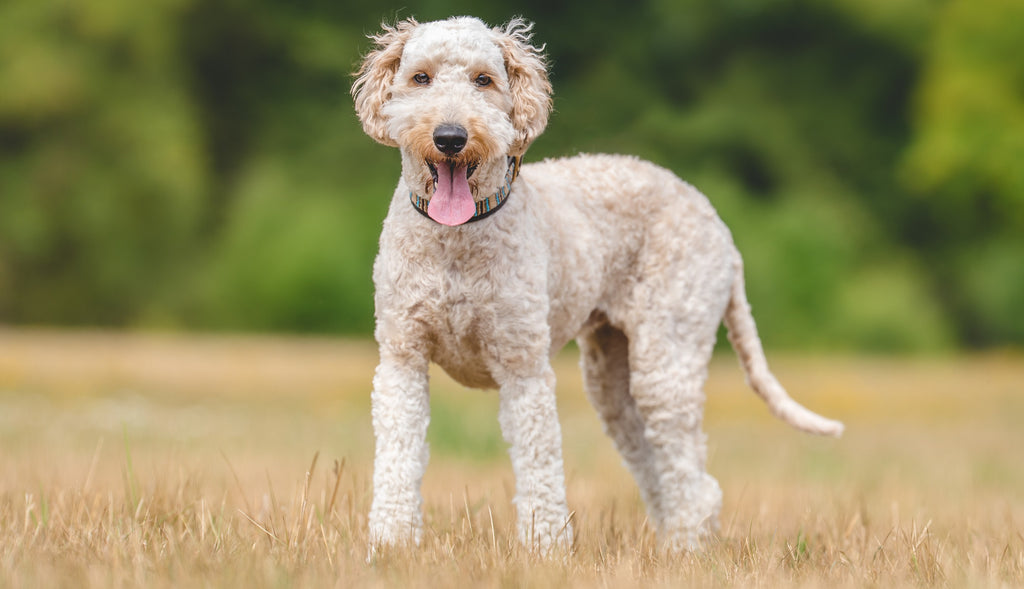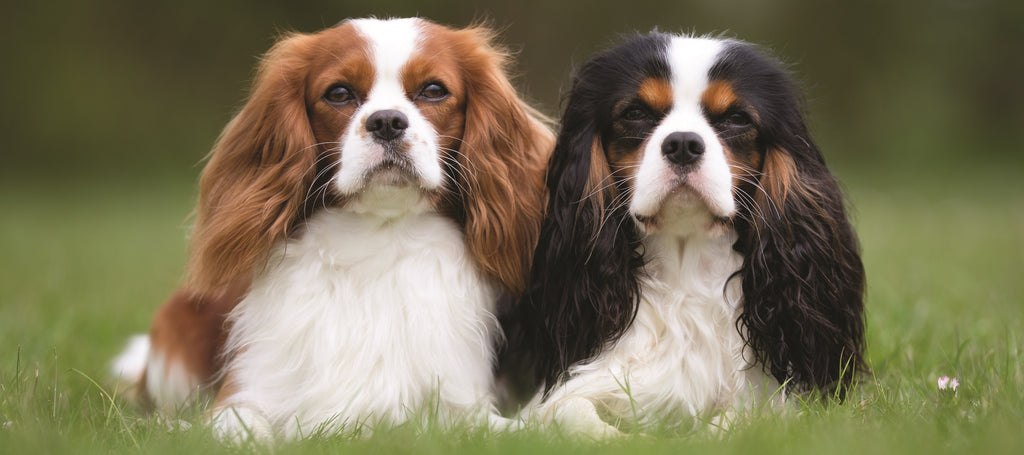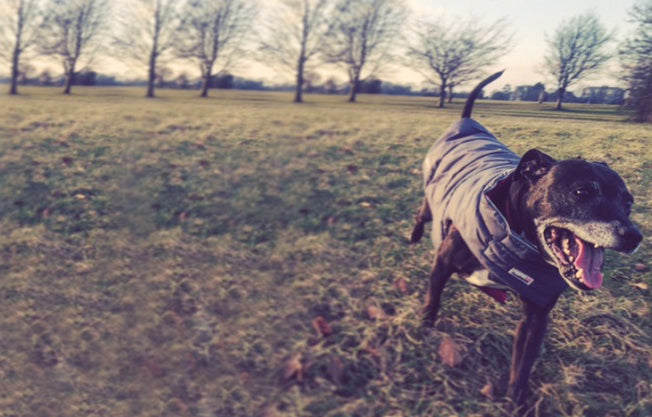
Exercising older dogs: Your questions answered
How should you exercise an older dog? Though they may be going grey, it’s still important to keep senior active. We answer some frequently asked questions about older dog exercise – from some top tips for adjusting your walks, to older dog joint supplements, and ways you can support your dog to help him feel happier.
Do older dogs need exercise?
In a word, yes. Older dogs – like older people – tend to be happier and healthier if they keep up appropriate regular exercise routines to suit their dog age and ability. The adage ‘move it or lose it’ is also true of most senior dogs! The fitter they are today, the more likely it is that they’ll be fit, happy and healthy tomorrow.
Of course, your vet is the best person to guide you on exactly how much exercise your older dog can comfortably enjoy, but there are lots of great reasons to keep your oldie active, including:
- Fun – almost all dogs love getting out for a walk, even if it’s a slow potter with lot of stops to sniff.
- Keeping in shape – building and maintaining muscle tone is a great way to support older joints.
- Bonding – taking time out of your day to spend time with your dog increases happiness for both of you.
- Weight management – extra weight can put unnecessary stress on your dog’s joints, so keeping them trim is a good idea. Older metabolisms can be slower too, as well as other medical conditions coming into play, so exercise programmes are really important and making sure to pay attention to your pooch.

How do you exercise older dogs?
Don’t give up
The most important thing is to keep up regular daily walks, even if they’re shorter and slower than in days gone by. It’s easy to just skip walkies when dogs get older, but it’s important to stick to a regular schedule to maintain fitness and happiness.
Take it steady
Older dogs may not be able to join you on runs and bike rides any more, but a gentle stroll with a few sniff-stops and rests is manageable for most. If your dog has lost strength in his or her back legs, they may do better walking uphill – the stronger front legs do the hard work. Then get the bus home for the downhill bit!
Modify your routes and routines
If the highlight of your dog’s day is an off-lead run in the park, but they’re tired by the time you get there, why not drive or take the bus with your senior dog when you head for green spaces? Skipping the street-walk saves energy so they can really enjoy their walkies, which will help to keep them active for longer. You can also modify doggie sports to be more suitable for oldies – lowering the fences and taking the course at a gentle trot at agility, for instance.

How do I help my old dog with stiffness?
Try a joint supplement
If your senior dog is experiencing stiff joints, a Green Lipped Mussel and Glucosamine joint supplement can help them to move more freely. YuMOVE Dog – our proven triple-action joint supplement for dogs who are stiff or getting older – soothes stiffness, supports long-term joint health and promotes mobility. Or, if your dog needs extra support, try YuMOVE Plus – our joint supplement for older dogs or those with more severe stiffness.
YuMOVE is proven to work in just 6 weeks*, thanks to ingredients like the world’s top strength, cold-extracted ActivEase™ Green Lipped Mussel and Glucosamine. That said, do be careful once your dog responds to the supplement – more comfortable joints may make them keen to do more exercise than your vet has recommended!
If you’re worried about your old dog getting stiff, speak to your vet for more support.
How do I help my dog if he gets tired on walks?
Consider a ‘pram’
There are some great doggie ‘strollers’ and ‘prams’ on the market these days, including ones suitable for larger breeds. Introduce the pram slowly and patiently with treats, and soon enough your oldie will be able to join you on longer walks again. Some can even attach to your bike!
Once they know there’s an option of a lift when they feel tired, your oldie may surprise you with just how far they can manage. One of us here at Lintbells has a very elderly staffie who has doubled her regular walking distance thanks to a pram that she can hop into for hills and boring bits.
For dogs who struggle with stairs and hills, another good option is a doggie sling. You pop it around their middle, hold on to the handles, and help to support their weight.

How long should I exercise my older dog for?
Keep it short and sweet
3-4 short walks is easier on your senior dog than one long one – and makes for a more interesting day for them. If you’re not a home in the day time, some dog walkers even offer shorter oldie walks. Instead of taking your oldie on a long ramble that may leave them stiff the next day, they might be able pop by for a couple of shorter visits.
My old dog doesn’t enjoy walks as much anymore. How can I help?
Support their mental health
As dogs get older, their vision and hearing can deteriorate, which can make the world feel like a scarier place. Aches and pains can make older dogs feel down too, so a mood-boosting, calming supplement like YuCALM Dog can really improve quality of life. Supplements for older dogs are a great way to give your pet the extra support it needs to enjoy its later life.
The results can be surprising:
“I tried YuCALM to help my 12-year-old dog cope with lots of travel and visitors over the festive season. Though it did help with that, what has really surprised me was how differently she behaved on walks. Over the senior years, she’d gradually become more fearful and shy out and about, I think due to her vet-supervised spondylosis and reduced vision. After a few weeks on YuCALM, she became much more outgoing, playful and puppylike, happier to meet other dogs, and keener to walk for longer. She’s been on it ever since…!”
- Ray Mills-Morrow, ‘mum’ to Maddie

My dog is less mobile but still enjoys going out. What can I do?
Go out on an urban exploration
If your dog is happy and confident in busy situations – and enjoys meeting new people – you might consider taking them on urban rambles. More smells, sights and sounds can make even very short walks great mental stimulation. Open air markets and adventures on public transport can also be great fun for confident dogs, especially if they love meeting new people. On rainy days, a walk around a pet store can be a great alternative to getting old bones cold and wet!
If your dog is more timid, stick to short, familiar routes, but try some new movements at home. Gentle tug of war can build strong neck and back muscles, ‘hide and seek’ with favourite toys is fun and your dog controls the pace, and you can even talk to your vet about yoga-style stretches and massages to suit your dog’s needs.
What are some extra ways to help old dogs exercise?
Here are a few other things you can try in order to keep your older dog active:
- Swimming and hydrotherapy – great for building strong muscles to support older bones.
- Short walks – to break up the day and increase steps. 3-4 x 15 minutes soon adds up!
- Brain games – for dogs who can’t physically manage lots of exercise, exercise their minds instead.
- Balance training – another good one to build muscle tone, there’s a great guide here.
- Trick training – you absolutely can teach old dogs new tricks, and training is a great way to bond with and tire out less mobile dogs. Why not teach your older dog to read or play dead?
Do you have any exercise ideas for oldies that other pet parents might find useful? Please do leave a comment – we always love hearing from you.
*Study conducted by Royal Veterinary College.






